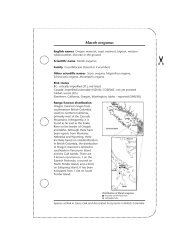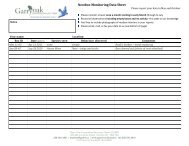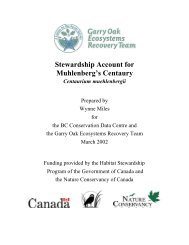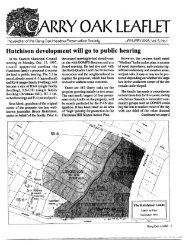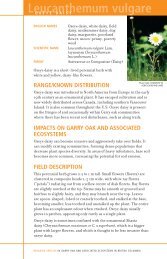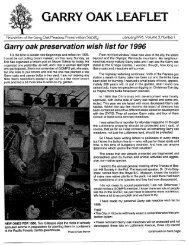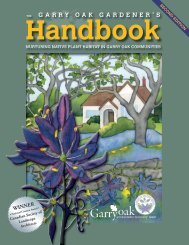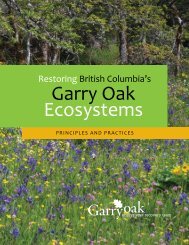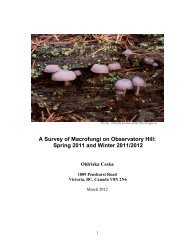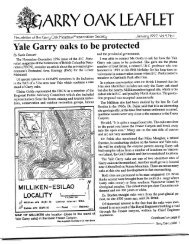PDF 320KB - Garry Oak Ecosystems Recovery Team
PDF 320KB - Garry Oak Ecosystems Recovery Team
PDF 320KB - Garry Oak Ecosystems Recovery Team
You also want an ePaper? Increase the reach of your titles
YUMPU automatically turns print PDFs into web optimized ePapers that Google loves.
INVASIVE SPECIES EFFECTS<br />
ECOLOGY, BIOLOGY AND CONTROL OF SOME<br />
EXOTIC-INVASIVE WEEDS ON FEDERAL LANDS<br />
IN BRITISH COLUMBIA, CANADA<br />
Raj Prasad, J. Benner and S. Bundel<br />
Formerly with Pacific Forestry Centre, Canadian Forestry Service,<br />
Victoria<br />
Scotch broom (Cytisus scoparius), gorse (Ulex europaeus), daphne<br />
(Daphne laureola) and English ivy (Hedera helix), are four<br />
prominent, invasive plants that pose a serious threat to <strong>Garry</strong> oak and<br />
associated ecosystems on federal lands in Victoria, British Columbia.<br />
These plants colonize disturbed areas quickly, form dense<br />
monospecific stands, remain persistent for a long time and defy any<br />
easy eradication program. They suppress and inhibit the growth of<br />
native plants and ultimately arrest forest succession. Several federal<br />
departments including the Department of Environment, Department<br />
of National Defense, Department of Fisheries and Oceans,<br />
Department of Indian Affairs and Parks Canada have expressed great<br />
concerns regarding their rapid incursion, adverse impacts and the<br />
resulting degradation of native habitats. With a grant from the<br />
Department of Environment and the Department of National<br />
Defense, we conducted research to examine the population dynamics,<br />
phenology and control methods of these invasive plants on federal<br />
lands near Victoria, B.C. Of the methods of control tested, including<br />
manual cutting, application of a registered herbicide (Releasetriclopyr),<br />
a fungal bioherbicide (Chondrostereum purpureum), and a<br />
commercial plastic mulch, it was found that the mulch and herbicide<br />
treatments provided 100% efficacy on reducing resprouting of all<br />
four invasive species. While one bioherbicide (Fusarium tumidum)<br />
was very effective on Scotch broom under greenhouse conditions, it<br />
was not applied under field conditions. The other bioherbicide<br />
(Chondrostereum purpureum) produced a variable response when<br />
applied under field conditions. Manual cutting was found to be the<br />
least effective. A novel prospective bioagent (Phomopsis sp. denovo)<br />
<strong>Garry</strong> <strong>Oak</strong> <strong>Ecosystems</strong> <strong>Recovery</strong> <strong>Team</strong> – Research Colloquium 2010 Page 12




